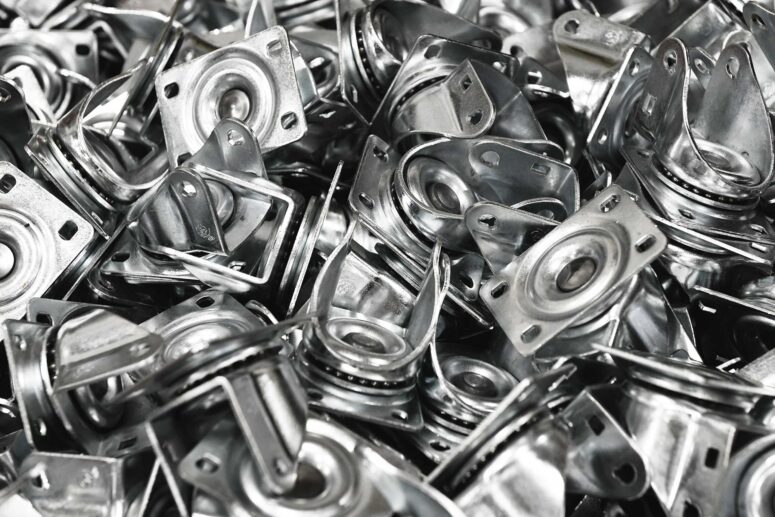After decades in the caster business, we’ve learned that specifying the right caster starts with asking the right questions. That’s true whether you’re outfitting medical carts, industrial racks, or custom-built machinery. Here are the questions we hear most often, answered with the insight of our CasterSmiths who have been solving mobility problems for years.
1. How do I determine the correct load capacity for a caster?
Start by calculating the maximum load your equipment will carry when fully loaded with materials. It’s not enough to base your numbers on the empty frame—you need to plan for the heaviest load that equipment will ever see. Once you’ve got that total, divide by three (not four). Why? In real-world settings, not every caster touches the ground at the same time, especially on uneven floors. For example, if your equipment fully loaded weighs 1,200 lbs., each caster should be rated for at least 400 lbs.
2. What mounting options are available for casters?
The three most common are top plates, stems, and bolt holes. Top plates offer the most stability and are common on heavy-duty equipment. Threaded stems and grip rings enable casters to be fastened to the legs of equipment and are great for lighter carts or where space is tight. One critical point—especially with stem fastenings—is to ensure they’re installed flush between the equipment and top washer. A loose or uneven stem mount can lead to bending or failure over time. Bolt hole casters require a smaller footprint, offer easy maneuvering in tighter spaces, and simple replacement or maintenance if something goes wrong.
3. How do I determine which wheel material is best for an application?
Choosing the right wheel material isn’t one-size-fits-all—it starts by asking the right questions. What kind of flooring will the caster roll over? Will there be exposure to water, chemicals, or extreme temperatures? Is noise a concern? Will the load be moved manually or with powered equipment? How heavy is the fully loaded equipment? And how often will it be moved?
These questions help guide material selection. For example, if you’re dealing with high loads, you might consider in-house moulded options like RollX™ for ergonomic ease or NyRock™ for maximum durability. Polyolefin is a versatile, lightweight alternative that holds up well under stress. In washdown or chemical-prone settings, thermoplastics or nylon are often the answer.
If you need help comparing options, check out our Wheel Comparison Chart and Chemical Resistance Chart.
4. Do I need casters with brakes or locks?
If your equipment needs to stay in place for safety or function, yes. There are several options: brakes that apply friction to the wheel, total-lock brakes that stop both the wheel and swivel, directional locks that hold the wheel straight, and 4-position swivel locks that allow repeatable alignment. In critical settings like hospitals, labs, and factory lines, these features aren’t optional—they’re essential.
We always recommend considering our iLock system. It’s a high-performance lock that combines total-lock braking with precise positional control. If you’re looking for something dependable and easy to use, this is it.
5. How does wheel diameter affect performance?
The diameter may be dictated by the required overall height of the caster. Beyond that, larger wheels roll more easily. They help overcome obstacles, reduce push effort, and protect against vibration. On the other hand, they are less stable. Smaller wheels save space and lower the center of gravity—but they’re best kept to smooth floors. Choosing the right diameter has a real ergonomic impact, especially if people are pushing the load manually. If you provide us with the specific application and the details of the environment, we can recommend the ideal diameter.
6. What maintenance is required for casters?
Routine checks are key. Inspect wheels for wear, check that fasteners are tight, and keep bearings lubricated unless they’re sealed. In rough-duty environments, aim for quarterly maintenance. And if your casters get hosed down or are used in wet conditions, stainless steel is the way to go. It’ll keep rust at bay and extend the life of your investment.
7. Can I customize casters for specific needs?
Absolutely—and often, you should. Whether it’s the custom overall heights or stem lengths, bearing type, swivel radius, or even finish, customizations help align the caster to the real-world demands of your application. Tight space? Specific mounting style? Need your brand colour on the wheel? We’ve done it all.
We excel at creating casters for custom applications. Because we handle everything in-house—from moulding wheels to welding rigs—we can turn around custom requests quickly and precisely.
Do you have more questions? We’re here to help.
Every project has unique needs, and the best solutions start with a conversation. Whether you’re building from scratch or upgrading your existing setup, we’re ready to roll up our sleeves and find the right fit. Request a quote or contact us and let’s get rolling.

